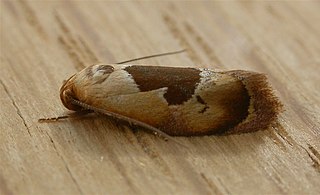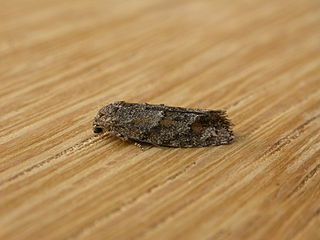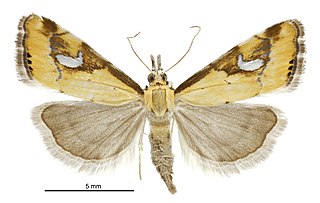
Hoplomorpha camelaea is a moth in the family Oecophoridae first described by Edward Meyrick in 1888. It is found in Australia, where it has been recorded from Victoria, Queensland, New South Wales and the Australian Capital Territory.

Agriophara nodigera is a moth of the family Depressariidae. It is found in Australia, where it has been recorded from Queensland.

Plectophila discalis is a moth of the family Xyloryctidae first described by Francis Walker in 1865. It is found in Australia, where it has been recorded from New South Wales, Queensland and Victoria.

Glaucocharis chrysochyta is a species of moth in the family Crambidae. This species was first described by Edward Meyrick in 1882. It is endemic to New Zealand and is found throughout the country. It inhabits native forest. Larvae appear to feed on moss and likely pupate there. Adult moths are on the wing from November to March. They fly at night and are attracted to light.

Glaucocharis lepidella is a species of moth in the family Crambidae. It was described by Francis Walker in 1866. It is endemic to New Zealand and is found in both the North and South Island. The species inhabits lowland to subalpine native forest. Larvae may feed on mosses. Adults are on the wing from November to February and are attracted to light.

Glaucocharis pyrsophanes is a moth in the family Crambidae. It was described by Edward Meyrick in 1882. It is endemic to New Zealand.
Catacometes hemiscia is a moth in the family Oecophoridae. It was described by Edward Meyrick in 1883. It is found in Australia, where it has been recorded from New South Wales.
Garrha costimacula is a moth in the family Oecophoridae. It was described by Edward Meyrick in 1883. It is found in Australia, where it has been recorded from Queensland and New South Wales.
Garrha leucerythra is a moth in the family Oecophoridae. It was described by Edward Meyrick in 1883. It is found in Australia, where it has been recorded from New South Wales and Tasmania.
Hoplomorpha notatana is a moth in the family Oecophoridae. It was described by Francis Walker in 1863. It is found in Australia, where it has been recorded from Queensland.
Catoryctis nonolinea is a moth in the family Xyloryctidae. It was described by Thomas Pennington Lucas in 1894. It is found in Australia, where it has been recorded from New South Wales and Queensland.

Cryptophasa albacosta, the small fruit tree borer, is a moth in the family Xyloryctidae. It was described by John Lewin in 1805. It is found in Australia, where it has been recorded from New South Wales, Queensland, South Australia, Tasmania and Victoria.
Lichenaula laniata is a moth in the family Xyloryctidae. It was described by Edward Meyrick in 1890. It is found in Australia, where it has been recorded from New South Wales and Queensland.
Lichenaula comparella is a moth in the family Xyloryctidae. It was described by Francis Walker in 1864. It is found in Australia, where it has been recorded from New South Wales and Queensland.
Lichenaula undulatella is a moth in the family Xyloryctidae. It was described by Francis Walker in 1864. It is found in Australia, where it has been recorded from New South Wales, Queensland and Western Australia.
Xylorycta amblygona is a moth in the family Xyloryctidae. It was described by Alfred Jefferis Turner in 1900. It is found in Australia, where it has been recorded from New South Wales and Queensland.
Eclecta is a monotypic moth genus in the family Depressariidae. Its only species, Eclecta aurorella, has been found in the Australian state of New South Wales. Both the genus and species were first described by Edward Meyrick in 1883.

Thudaca heterastis is a moth in the family Depressariidae. It was described by Edward Meyrick in 1893. It is found in Australia, where it has been recorded from Western Australia.

Agriophara confertella is a moth in the family Depressariidae. It was described by Francis Walker in 1864. It is found in Australia, where it has been recorded from Queensland, New South Wales and the Australian Capital Territory.
Imma autodoxa is a moth in the family Immidae. It was described by Edward Meyrick in 1886. It is found on Fiji.









